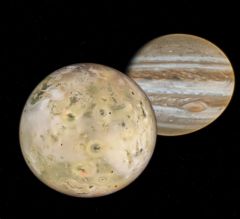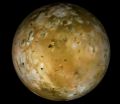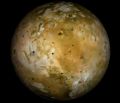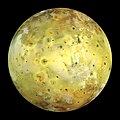Difference between revisions of "Io"
Jump to navigation
Jump to search
(Added image.) |
(Added link, image, content for Voyager1Jupiter.zip.) |
||
| Line 16: | Line 16: | ||
!bgcolor="lightsteelblue" colspan="2"|Planetary mean orbits | !bgcolor="lightsteelblue" colspan="2"|Planetary mean orbits | ||
|- | |- | ||
| − | |width="30%"|Epoch||align="right" width="50%"| | + | |width="30%"|Epoch||align="right" width="50%"|1979.12391832712 (1979 February 14 061605 UTC) |
|- | |- | ||
| − | |width="30%"|Semimajor axis (a)||align="right" width="50%"| | + | |width="30%"|Semimajor axis (a)||align="right" width="50%"|422025278.692653 m |
|- | |- | ||
| − | |width="30%"|Eccentricity (e)||align="right" width="30%"|0. | + | |width="30%"|Eccentricity (e)||align="right" width="30%"|0.00418867166362767 |
|- | |- | ||
| − | |width="30%"|Inclination (i)||align="right" width="30%"| | + | |width="30%"|Inclination (i)||align="right" width="30%"|2.18312929° <br> (0.0381027941060868 radian) |
|- | |- | ||
| − | |width="30%"|Longitude of the ascending node (LAN, ☊)||align="right" width="30%"| | + | |width="30%"|Longitude of the ascending node (LAN, ☊)||align="right" width="30%"|337.6180631° <br> (5.8925468154509 radian) |
|- | |- | ||
| − | |width="30%"|Longitude of periapsis (ϖ)||align="right" width="30%"| | + | |width="30%"|Longitude of periapsis (ϖ)||align="right" width="30%"|654.3518983° <br> (11.4205950913623 radian) |
|- | |- | ||
| − | |width="30%"|Mean longitude (L)||align="right" width="30%"| | + | |width="30%"|Mean longitude (L)||align="right" width="30%"|737.1542087° <br> (12.8657680372413 radian) |
|- | |- | ||
!bgcolor="lightsteelblue" colspan="2"|Selected physical parameters | !bgcolor="lightsteelblue" colspan="2"|Selected physical parameters | ||
| Line 36: | Line 36: | ||
|width="30%"|Mass||align="right" width="30%"|8.93×10<sup>22</sup> kg | |width="30%"|Mass||align="right" width="30%"|8.93×10<sup>22</sup> kg | ||
|- | |- | ||
| − | |width="30%"|Note||align="right" width="30%"|*Elements given are from Io.cfg ( | + | |width="30%"|SidRotPeriod||align="right" width="3-%"|152841.6 sec (42.456 hours) |
| + | |- | ||
| + | |width="30%"|Note||align="right" width="30%"|*Elements given are from Io.cfg (Voyager1Jupiter.zip) | ||
|} | |} | ||
| Line 65: | Line 67: | ||
Io-orbiter2002p3.jpg|<center>Io in Orbiter 2002P3</center> | Io-orbiter2002p3.jpg|<center>Io in Orbiter 2002P3</center> | ||
Io-Orbiter2003P2.jpg|<center>Io in Orbiter 2003P2</center> | Io-Orbiter2003P2.jpg|<center>Io in Orbiter 2003P2</center> | ||
| + | Io-Voyager1Jupiterzip-Orbiter2003P2.jpg|<center>Io from ''Voyager1Jupiter.zip'' in Orbiter 2003P2</center> | ||
Io highest resolution true color.jpg|<center>Io as seen by the [[w:Galileo (spacecraft)|Galileo]] spacecraft on 3 July 1999<br>from Wikimedia Commons</center> | Io highest resolution true color.jpg|<center>Io as seen by the [[w:Galileo (spacecraft)|Galileo]] spacecraft on 3 July 1999<br>from Wikimedia Commons</center> | ||
Galilean moon Laplace resonance animation 2.gif|<center>Animation of three inner Galilean moons showing orbital resonance</center> | Galilean moon Laplace resonance animation 2.gif|<center>Animation of three inner Galilean moons showing orbital resonance</center> | ||
Revision as of 11:16, 9 September 2024
 | This natural satellite related article is a stub. You can help Orbiterwiki by expanding it.
Io is one of Jupiter's four Galilean Moons. It is also the only confirmed satellite to have active volcanoes. Its orbit is in a 1:2:4 resonance with Europa and Ganymede. Io in OrbiterIo was introduced to Orbiter in the Orbiter 2002 release, and each version after that. Io's orbit was governed by the Io.cfg file in Orbiter 2002 and later versions until Orbiter 2005 when Vsop87.dll governed Io's orbit. Io is modeled as a sphere 48806 km in diameter with a mass of 8.93×1022 kg.
See alsoGallery
| |||||||||||||||||||||||||||||||||||||||||||||||||






